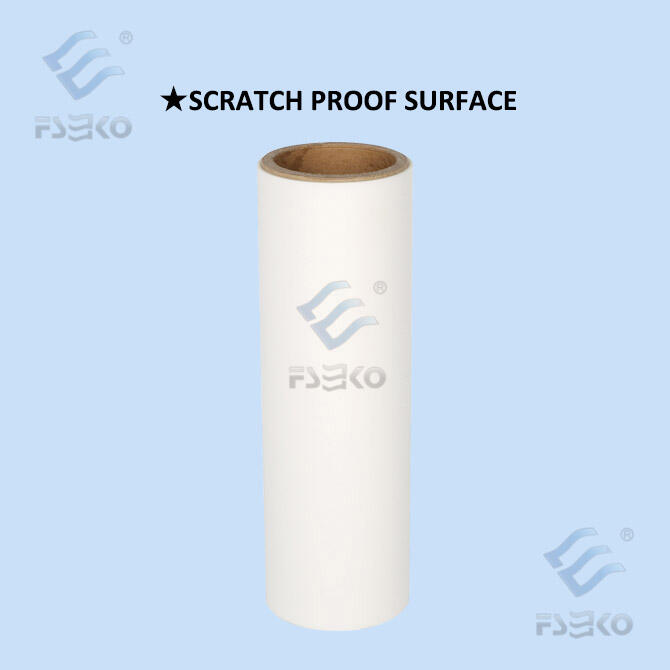Understanding Anti-Scratch Thermal Lamination Film
What Makes Anti-Scratch Film Unique?
Anti-scratch thermal lamination film stands out due to its special coating that enhances durability and protects contents from minor scratches. This unique coating provides significant resistance to physical damage, ensuring that printed materials remain intact and aesthetically pleasing for longer periods. According to industry experts, these films significantly outperform traditional lamination in preventing scuff marks, thereby extending the lifespan of books and packaging materials. For instance, a study highlights that the anti-scratch film can boost the durability of materials by up to 50%, making it a preferred choice for premium products. These films are ideal for sectors requiring high-quality finishes, such as custom packaging and elegant book covers.
Key Components: BOPP vs. PET Films
When comparing BOPP (Biaxially Oriented Polypropylene) and PET (Polyethylene Terephthalate) films, it is essential to note the differences in material properties and their impact on lamination quality. BOPP films are known for their flexibility and excellent clarity, which contribute to a superior finish. In contrast, PET films offer more robustness and are generally stiffer but still provide a high level of transparency. Environmentally, BOPP films are biodegradable and offer ease of recyclability, making them a more eco-friendly option compared to PET films, which are less biodegradable but sturdy. Understanding these differences can help consumers and businesses select the appropriate film that balances quality and environmental impact. This choice is especially important when deciding the type of lamination for specific applications, such as flexible packaging or graphic media.
Benefits of Anti-Scratch Thermal Lamination
Enhanced Durability for Long-Lasting Protection
Anti-scratch thermal lamination significantly enhances the durability of printed materials by protecting them against daily wear and tear. This type of lamination forms a robust barrier that guards against damage, effectively extending the lifecycle of print materials. A survey conducted in the printing industry revealed that businesses adopting anti-scratch lamination observed a 40% increase in product lifespan. From a financial perspective, the prolonged durability reduces the necessity for frequent replacements, leading to substantial cost savings over time. Organizations can thus allocate resources more efficiently, knowing their printed assets are protected.
Resistance to Scuffs, Scratches, and UV Fading
One of the key advantages of anti-scratch lamination is its exceptional resistance to scuffs, scratches, and UV fading. These films block harmful UV rays, preventing discoloration and degradation of materials over time. Scientific studies have shown that UV protection in lamination extends the life of products by 30%, maintaining their integrity and appearance longer. Some anti-scratch films even have certifications verifying their UV resistance capabilities, ensuring they meet rigorous environmental protection standards. This resilience to environmental factors makes them a valuable choice for various applications.
Improved Aesthetic Appeal with Matte Finish
The anti-scratch thermal lamination not only offers durability but also enhances the aesthetic appeal of printed materials through a matte finish. This finish elevates the visual quality by providing a sophisticated, non-reflective surface that highlights printed content while minimizing glare. Customer testimonials often praise matte finishes for their elegant and contemporary look, contrasting them favorably against traditional glossy ones, which can sometimes appear overly reflective. Current design trends prioritize matte finishes due to these aesthetic benefits, making them popular in modern packaging and printing projects.
How to Apply Anti-Scratch Thermal Lamination Film
Step-by-Step Application Process
Implementing the correct application process for anti-scratch thermal lamination film is essential for optimal results. Start by gathering the necessary tools, including the laminator itself, lamination film, a trimmer, and a cleaning cloth. Follow these steps which align with industry standards:
- Prepare the Lamination Machine: Ensure the laminator is clean and free from any residual dust or debris that could affect quality.
- Select the Correct Film and Substrate: Choose a lamination film that matches your substrate in size and type to prevent misalignment or grain discrepancies.
- Load the Film: Carefully position the film, aligning it with the machine guidelines for straight feeding.
- Adjust Settings: Set the appropriate temperature and feed speed for your specific lamination film.
- Feed the Substrate: Align the paper grain parallel to the rollers to prevent wrinkling issues.
- Execute the Lamination: Start the lamination process, ensuring an even feed to avoid bubbles or wrinkles.
Following these steps facilitates a smooth lamination process, eliminating common pitfalls.
Optimal Temperature and Pressure Settings
Effective lamination requires adherence to optimal temperature and pressure settings that ensure quality results. Typically, the temperature for anti-scratch films ranges between 100-130°C, depending on the substrate and film type. It's crucial to apply proper pressure as well; too much or too little can impact the film's adhesion and the laminated material's appearance. Industry experts recommend a pressure setting that achieves a firm bond without distorting the paper or film.
Inadequate temperature or pressure can cause issues like silvering or poor adhesion, as the adhesive may not fully activate. Data shows that maintaining consistent temperature and pressure settings across the lamination width is key to ensuring high-quality finishes. Testing settings on a sample substrate can help identify the optimal configuration, fine-tuning according to film thickness and material.
Avoiding Common Errors (Wrinkles, Bubbles)
Identifying and mitigating common lamination errors such as wrinkles and bubbles enhances the final product quality. These imperfections often stem from incorrect substrate feeding or film-to-paper alignment. To prevent wrinkles, verify the substrate’s grain direction is parallel to the laminator rollers and ensure uniform tension across the feed.
For bubbles, monitor the heat and pressure levels closely. Insufficient heat might fail to bond the film properly, causing air pockets. To troubleshoot these issues, periodically clean the laminator rollers, ensure accurate substrate alignment, and adjust heat and pressure settings as required.
Incorporating these preventative strategies allows operators to maintain seamless lamination workflow and high-quality output consistently.
BOPP vs. PET: Choosing the Right Film
Comparing Flexibility and Clarity
When selecting a lamination film, flexibility and clarity are critical factors. BOPP (Biaxially Oriented Polypropylene) films are known for their amazing flexibility, making them suitable for a wide range of applications, from packaging flexible items to preserving documents and artwork. On the other hand, PET (Polyethylene Terephthalate) films offer moderate flexibility but excel in providing high-quality clarity, which is essential for visual presentations where crystal-clear imagery is a must. According to industry experts, choosing the right material hinges largely on the specific requirements for flexibility and clarity. For instance, in situations where high clarity is needed, such as in high-end graphics displays, PET would be preferred. Conversely, BOPP’s flexibility and clarity make it ideal for uses where both these attributes are essential.
Adhesion Strength and Environmental Resistance
Adhesion strength and environmental resistance are crucial when deciding between BOPP and PET films. BOPP films showcase excellent adhesion capabilities, particularly on paper, due to their engineered surface properties, making them highly sought after in the packaging and printing industries. Under humid conditions or when exposed to fluctuating temperatures, BOPP films tend to maintain their structural integrity, which ensures consistent performance. Conversely, PET films are noted for their robust adhesion strength across a variety of surfaces, along with outstanding resistance to environmental factors like UV radiation and moisture. Studies show that PET films outperform in high-humidity environments. Expert evaluations suggest using BOPP for short-term solutions or where humidity is controlled, while PET is recommended for products needing long-term durability and high resistance in challenging environments.
Ideal Use Cases for Each Material
Understanding when to use BOPP over PET films involves identifying specific industry and application needs. BOPP films are excellent for general-purpose packaging, labeling, and document protection because of their balance between cost-effectiveness and performance. BOPP is often favored in the food packaging industry due to its excellent grease and water resistance. Meanwhile, PET films find their ideal use in applications requiring high-temperature resistance, such as identity cards and credit card covers, due to their superior clarity and structural strength. Professionals in the printing and graphic arts industries often lean towards PET for applications that require the film to maintain transparency under various lighting conditions. These insights demonstrate that selecting between BOPP and PET depends on the specific requirements of the task at hand, ensuring optimal performance and satisfaction.
Troubleshooting Anti-Scratch Film Issues
Solving Adhesion Problems
Adhesion problems with lamination films can manifest as peeling, bubbling, or weak bonds between the film and substrate. Common culprits include insufficient heat, pressure, or incorrect run speeds. To troubleshoot, start by ensuring the laminator is set to the correct temperature for your specific film. Slowly lower the run speed to give the adhesive adequate time to soften and bond effectively. If issues persist, consult best practices such as testing new materials pre-run and ensuring ink has completely dried before laminating. Experts recommend matching the adhesive type to the substrate and verifying machine calibration regularly to minimize adhesion problems.
Preventing Silvering and Haziness
Silvering, which appears as tiny bubbles, and haziness can compromise the clarity of laminated materials. These issues typically arise from inadequate heat, pressure, or uneven roller temperatures. To prevent silvering, increase the temperature and pressure gradually while adjusting the tension to minimize shrinkage. For haziness, ensure the laminator rollers are evenly heated and maintain smooth operations to distribute heat consistently. By aligning with industry standards like maintaining regular equipment checks and optimizing fill combinations for smoothness, one can achieve optimal clarity and avoid these common pitfalls.
Maintenance Tips for Consistent Results
Maintaining lamination equipment is pivotal for guaranteeing consistent quality and prolonging machinery lifespan. Establishing a regular maintenance routine involves cleaning rollers, checking calibration, and replacing worn parts as needed. These steps prevent issues like uneven pressure or heat distribution, which can affect lamination quality. Quality checks during production stages can identify potential faults early. Adopting a proactive maintenance schedule, such as regular visual inspections and scheduled deep cleaning, will ensure smooth, high-quality lamination results over time.


